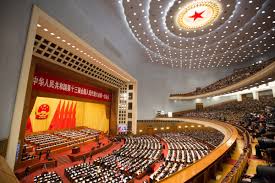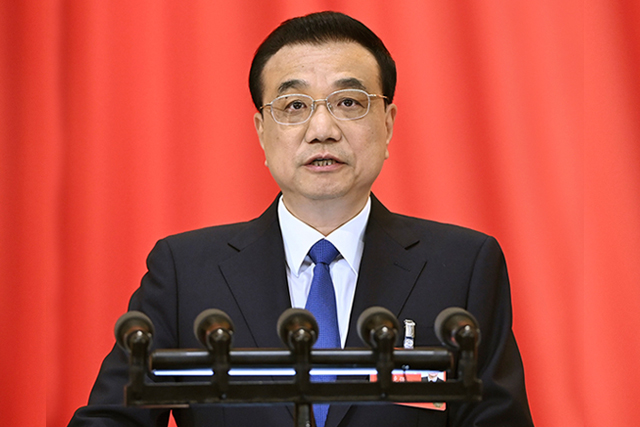Starting on May 21, 2020 and ending on May 28, 2020, China held its National People’s Congress (NPC) and the Chinese People’s Political Consultative Congress (CPPCC) – commonly known as the „two sessions“ or 两会 (Liang Hui). The two sessions were clearly influenced by the Covid19 outbreak: the sessions had to be delayed by 3 months, had to be shortened, and of course their content was revolving around national economic recovery, national security and upgrading health systems at home and in the “Health Silk Road”.
Find the Chinese version (新冠肺炎疫情下,两会之后,“一带一路”倡议将何去何从) of the article here.

The CPPCC with its approximately 2.200 representatives is China’s top political advisory committee without the power to make laws. The CPPCC makes recommendations to the government on all types of political issues. The National Party Congress (NPC), which meets also once a year, is in principal the lawmaking body with close to 3.000 representatives. The de-facto law-making of the NPC is in approving laws.
To understand China’s green or non-green development strategies at home and in the Belt and Road Initiative (BRI), we analyzed the proposals, presentations and decisions during the two sessions. Hence, this is a first article to analyze the two sessions in conjunction with relevant laws and opinions that different ministries and agencies published in the run-up of the two sessions, particularly:
- Opinions of the Central Committee of the Communist Party of China on Speeding Up the Perfection of the Socialist Market Economic System in the New Era published on May 11, 2020
- Guiding Opinions on Establishing a Modern Environmental Governance System published on March 3, 2020
- Notice of the Ministry of Industry and Information Technology on promoting the accelerated development of 5G Ministry of Industry and Information Technology, published on March 24, 2020
- Guiding Opinions of the Central Committee of the Communist Party of China on the New Era to Promote the Development of the Western Region in the New Era, published on May 18, 2020
We will focus on 5 questions:
- What impacts does Covid-19 have on the Belt and Road Initiative?
- What are specific areas of development for the BRI in the near future
- What role does green development play in the Belt and Road Initiative in the recent meetings?
- What are changes we can expect for the future of cooperation in the Belt and Road Initiative?
- What we hope to hear behind the scenes (but haven’t heard… yet)?
1. Is the Belt and Road Initiative influenced by Covid-19?
- Over the past months, many ongoing BRI projects had to be postponed or halted as Chinese workers were unable to travel to the BRI countries to continue construction on infrastructure projects, e.g. in Pakistan, Myanmar, and Malaysia . Also, some contract-signing of projects are delayed, such as the Bangkok-Nakhon-Ratchasima section of Thailand’s high-speed rail.
- Si Zefu, Chairman and Party Secretary of Harbin Electric Group (one of the world’s largest construction companies for energy infrastructure) told the CPPCC that due to the global economic downturn, Chinese companies are facing difficulties in implementing projects or developing new projects. He also worried about the ability of projects to be paid in time or at all. Accordingly, he stated that “based on commercial logic and market rules, we should further emancipate our minds, expand our thinking, and increase support for the ‘Belt and Road Initiative’ project financing model.”
- Luo Yan, Marketing Director of National Machinery Group told the CPPCC that the business model of ‘general project contracting + financing (EPC + F)’ has been impacted by China’s overseas project contracting enterprises, and “it is high time to increase support for enterprises to carry out third-party cooperation and invest/build/operate business.”
- At the same time, projects continue to be signed, such as the USD 3 billion Budapest-Belgrade high-speed rail financed by China Exim Bank.
- Wang Yi, China’s foreign minister, stressed during the two sessions that China’s interest in the BRI is “unchanged” no matter the covid outbreak. Ji Zhe, Director of the National Development and Reform Commission (NDRC) said that trade with the BRI countries during the outbreak even grew by 3.6% – against the global trend of declining trade.
2. What are specific areas of development for the BRI in the near future
- Classic infrastructure development, particularly road, rail and water transportation, as well as dry and wet ports that help accelerate trade, will be boosted within China: The Western regions, including Xinjiang, Yunnan, Chongqing, Sichuan and Shaanxi are encouraged to strengthen their transport capacity to enable trade between Europe and China (Xinjiang), as well as South East Asia and China (Kunming). At the same time, China aims to “promote the construction of new land-sea passages in the West” – which implies an accelerated connection through the China Pakistan Economic Corridor (CPEC). This would give China strategic access to Africa through the Arabian Sea circumnavigating India. Many provinces are seeing opportunities to align with the BRI. Jiangsu’s representative, for example, said at the two sessions: “we will fully implement the “five major plans” and focus on building a “One Belt And One Road” intersection with global influence. In 2020, Jiangsu will complete the establishment of a provincial-level international freight train company”
- Construction of free trade zones and free trade ports “with Chinese characteristics” will play a large role both within China and outside China, according to Luo Shaming,Member of the National Committee of the CPPCC. One particular development zone is the Yangtze River (which is also the most important bio-diversity protection zone of China), with role models being China (Shanghai) Free Trade Zone and Hainan Free Trade Port.
- The roll-out of a digital silk road will be accelerated. This also includes increased investments in 5G networks in China and the BRI countries, as both Wang Yi, China’s foreign minister, and Ji Zhe, Director of the NDRC, elaborated. Furthermore, as Li Keqiang mentioned, cross-border e-commerce is an important pathway to accelerate economic growth in China.
- The health silk road will get a boost (for an overview, see also here: http://greenfdc.org/chinas-healthcare-industry-in-bri-international-cooperation). With BRI countries struggling to deal with the Covid crisis, BRI countries look to China for support. Diya Hermi, Secretary-General of the Egyptian-China Chamber of Commerce said: “China has gained unique experience in epidemic prevention and control, which makes it particularly important to strengthen health cooperation under the ‘One Belt And One Road’ framework.” China is expected to use the health silk road as a development tool (e.g. by promising USD 2 billion to help emerging economies deal with the crisis. President Xi offered this help during the May 18 WHO meeting, with the money being deployed bilaterally rather than through multilateral donor channels, such as the WHO). Some also see it as an inexpensive tool to expand China’s soft power.
- Soft connectivity, including standards and governance models with Chinese leadership, will increasingly pushed as much as possible. This should allow China to both accelerate trade flows (e.g. in border crossings), and increase trade with China as a standard setter and convener. Chen Yixing, member of the CPPCC also suggested to improve legal standards along the BRI along bilateral and multilateral cooperation mechanisms to overcome differences of legal protection and law implementation in BRI countries.
3. What role does green development play in the Belt and Road Initiative?
- Wang Yi, China’s foreign minister, promised to uphold the principles of “open, green and clean development” of the BRI. Otherwise, green BRI development did not feature prominently.
- Overall, it seems that China’s green development will focus on specific areas (e.g. Yangtze River), as well as domestic reduction of air pollution (e.g. by accelerating clean coal development and retrofitting), soil and water pollution (e.g. through relocation of chemical industry). Huang Runqiu, Minister of Ecology and Environment, hinted in an interview he gave during the two sessions that the 14th Five-Year Plan (which should be released later this year) might see more ambition to reduce greenhouse gas emission intensity.
4. What are changes we can expect for the future of cooperation in the Belt and Road Initiative?
- China will focus on regional development with its near neighbours: as many BRI countries face economic difficulties in the wake of the covid pandemic, many also struggle to repay debt owed to China, other countries and investors. This possibly decreased risk appetite for Chinese investors going into BRI countries. Li Keqiang implied as much when saying that China will focus on advancing the signing of the Regional Comprehensive Economic Partnership (RCEP) which includes 15 ASEAN member states and five ASEAN FTA partners in the Indo Pacific (with the exception of India), as well as with free trade agreements with Japan and Korea.
- China hopes to accelerate the engagement of its overseas “compatriots” to promote BRI development. Zhu Yilong, Member of the CPPCC and Group Chairman of the China Federation of Overseas Chinese said that “overseas Chinese have the advantages of integrating with the outside world and are an important force in the development of the “One Belt And One Road””. Therefore, he suggested to utilize overseas Chinese associations in border areas, strengthen people-to-people exchanges, and actively integrate them to serve “One Belt And One Road” development.
5. What we hope to hear behind the scenes (but haven’t heard… yet)?
- Who will invest in the BRI. Prime Minister Li Keqiang said that development of the BRI should give “full scope to enterprises as the main actor”. It is not clear whether he was talking about private enterprises or state-owned enterprises.
- How much will BRI investments be? While China also struggles economically and did not set a growth target for 2020, it’s outward investments might be hampered (we estimate at 50% from 2019, so about 40-50 bn USD in the BRI). We also think that China’s financial institutions will support investments in strategic and underpriced assets in non-BRI countries (over risky BRI investments), such as flailing tech companies and strong brands.
- How to strengthen international cooperation: While China sees attracting international investments for boosting economic growth in China as a priority, international cooperation for investing in the BRI has seen close to no attention in these meetings. While the EU-China summit is still being planned for September 2020 – at least from the German side (who is hosting the event), the topic of South-South cooperation did not feature at these meetings. We believe this is a great opportunity to look at cooperation opportunities, e.g. in ecological development.
- How to strengthen international knowledge exchange (besides in fighting the Covid-19 battle): Compared to previous years, China has become more assertive. International cooperation is seen as a way to support other countries through China – not for China to learn. According to the foreign minister, particularly developing countries and neighbouring countries should benefit from Chinese experiences. The foreign minister also stressed that “We will resolutely defend China’s sovereignty, security and development interests with stronger will/measures, and resolutely guard against attempts by external forces to interfere in China’s internal affairs”. We would hope to see ideas how China could also improve its environmental governance and practices with international best practice experiences (e.g. in financial institutions through the adoption of the Equator Principles).
- How to address concerns about the BRI: Little was talked about possible environmental challenges and soft-power challenges caused by the Belt and Road Initiative. On the one hand are reports that African diplomats summoned their Chinese counterparts and publicly chastised them for the treatment of African students in China and that African netizens have expressed concerns of Chinese influence in their countries. On the other hand are environmentally challenging projects, 60 of which had been collected and sent to the Minister of Commerce and other Ministries in China by over 200 NGOs. It is little surprise that none of these issues were addressed at the meetings directly – but we believe these are concerns that can easily be addressed through more transparency, openness and mutual recognition of sometimes conflicting interests.
Dr. Christoph NEDOPIL WANG is the Founding Director of the Green Finance & Development Center and a Visiting Professor at the Fanhai International School of Finance (FISF) at Fudan University in Shanghai, China. He is also the Director of the Griffith Asia Institute and a Professor at Griffith University.
Christoph is a member of the Belt and Road Initiative Green Coalition (BRIGC) of the Chinese Ministry of Ecology and Environment. He has contributed to policies and provided research/consulting amongst others for the China Council for International Cooperation on Environment and Development (CCICED), the Ministry of Commerce, various private and multilateral finance institutions (e.g. ADB, IFC, as well as multilateral institutions (e.g. UNDP, UNESCAP) and international governments.
Christoph holds a master of engineering from the Technical University Berlin, a master of public administration from Harvard Kennedy School, as well as a PhD in Economics. He has extensive experience in finance, sustainability, innovation, and infrastructure, having worked for the International Finance Corporation (IFC) for almost 10 years and being a Director for the Sino-German Sustainable Transport Project with the German Cooperation Agency GIZ in Beijing.
He has authored books, articles and reports, including UNDP's SDG Finance Taxonomy, IFC's “Navigating through Crises” and “Corporate Governance - Handbook for Board Directors”, and multiple academic papers on capital flows, sustainability and international development.





Comments are closed.